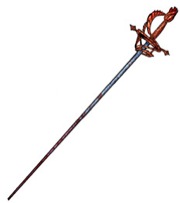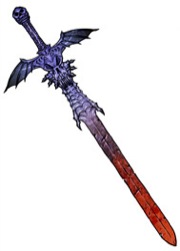Pathfinder to get the new Smart SwordTuesday, January 11, 2011
Welcome to the first Design Tuesday blog, a series of blogs that explore the rules of the Pathfinder Roleplaying Game. Over the next few weeks, we're going to be exploring intelligent magic items and how to use them in your game.
Intelligent Magic Items: Part 1

Adding magic items to your game is already a time-consuming process. As a GM, you must evaluate the party's needs, look at their wealth levels, and assign appropriate and fun items to the hoards they might discover. Adding an intelligent magic item to the mix is often seen as one step too many, combining the treasure distribution rules with many of the aspects of NPC creation. There are, however, a number of reasons to put an intelligent magic item into your game, making them more than worth the extra effort.
Intelligent magic items are a useful way for the GM to directly participate in the narrative of the campaign whenever it's convenient. The magic item is always with the group, but unlike an ordinary NPC, no one expects an intelligent magic item to participate in every conversation or combat. An actual NPC that fades in and out of the scene can be jarring to some and, when forgotten, can lead to awkward situations where the only solution is to revise history. An intelligent magic item, however, can easily speak up when it has something vital to add, and can just as easily be silent without breaking any sense of verisimilitude. Intelligent items are a perfect means for adding twists and turns to an adventure, while allowing the PCs to feel like they are in control.
Before adding an intelligent magic item into your game, you should first design an adventure or plotline around the object. To get the most out of an intelligent item, it should be featured heavily in at least one adventure or arc in the campaign. This makes the item special and lets it stand out. Giving the item this much spotlight will also greatly help develop its personality and background. This adventure does not have to take place the moment the item is acquired, but it should be known during the process of creating the item, as it will drive many of your design decisions. Treat the item like an NPC. It has motivations and some sort of goal or desire. At the very least, it has a history to draw upon. Here are a few example adventure seeds that involve some sort of intelligent item:
The magic item was once the property of a renowned adventurer who died in a deadly dungeon. The item remembers much of the layout of that dungeon and might be able to aid its new owner in navigating the deathtrap.
The magic item was used to store the soul of a powerful spellcaster who desperately wants to be restored to life. The item knows the one way that this can be accomplished—by taking the item to a unique mountaintop shrine.
The item was once the property of an angelic being, but fell into the hands of an evil creature that never knew its true power. Now recovered, the item wishes to complete the quest of its slain master. Unknown to the item, its original master still lives and is seeking the item.
These are just some of the possible stories that involve an intelligent item. Once you've got the background and goal of the magic item worked out, it's time to design the item and introduce it to the group. We'll cover some design tips and tricks in part 2 of this series, so for now, let's look at how to introduce the item to the group. There are many ways that an intelligent item might find its way into the hands of a PC, the simplest being inclusion in a treasure hoard or as part of a villain's gear. There are also less conventional means that you might want to consider:
The item belongs to a merchant who is tired of its constant bickering and talking and is desperate to be rid of the item. He practically gives it away to the first PC who seems remotely interested in it.
The item's previous owner thought it was haunted and threw it away—down a well, into a fireplace, etc. The PCs stumble upon it and save it from destruction or neglect.
The PCs encounter the item's current owner, who the item finds totally unsuitable to its purpose. In an obvious battle of wills, the item forces its current owner to hand the item over to the most suitable PC.

Once the PCs have the item, it's time for it to introduce itself. This should not happen right away. Intelligent items have a tendency to make themselves known only once their owner has proven to be worthwhile (or so terribly unsuitable to the item that it cannot stand the misuse any longer). This should be a memorable encounter, where the item suddenly speaks out or uses an ability unknown to its new owner. After the first encounter, the PCs will undoubtedly have a lot of questions for the item. Make sure to be careful with what the PCs know at first. The item cannot usually leave if its owner decides to mistreat it, and as a result, most intelligent magic items guard their secrets carefully and only reveal all to an owner that they trust implicitly. Remember the item's true goals or purpose throughout this process. While the PCs should not learn this right away, they might get a clue from these first conversations.
From this point onward, the item can act as an occasional source of information, throwing out bits and pieces of knowledge as needed by the GM, so long as they can be made to fit in the object's story. The item can be used as a foil for a PC who thinks too much of himself, or to bolster a lowly character's confidence. An intelligent magic item is a valuable tool, one that every GM should consider adding to the campaign.
That's all for this week. Next week we'll look at the mechanics behind designing an intelligent magic item, and even give you some new rules to work with.
Jason Bulmahn
Lead Designer
We have updated our Privacy Policy.
Paizo.com uses cookies. You can block paizo.com from using cookies within your browser settings, but doing so will hinder site functionality.
More information can be found in our Privacy Policy.